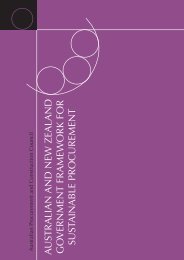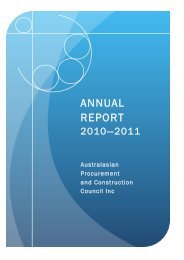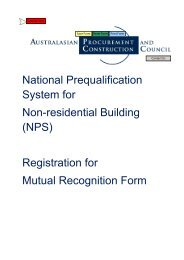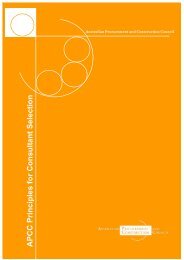ESD design guide for Australian Government buildings: Edition 2
ESD design guide for Australian Government buildings: Edition 2
ESD design guide for Australian Government buildings: Edition 2
You also want an ePaper? Increase the reach of your titles
YUMPU automatically turns print PDFs into web optimized ePapers that Google loves.
esd opportunities in building<br />
OPPORTUNITY 9<br />
water conservation<br />
Cooling towers<br />
• Making sure float valves are<br />
correctly set.<br />
• Installing a conductivity meter and<br />
automating the blow-down system<br />
to a pre-set conductivity level (Total<br />
Dissolved Solids concentration) of<br />
the re-circulating water.<br />
• Implementing ‘per<strong>for</strong>mance-based’<br />
maintenance.<br />
• Reducing heat loads by improving<br />
the energy efficiency of the building<br />
and energy services, which will<br />
also reduce the heat load on<br />
chillers and cooling towers.<br />
• Improving the overall efficiency of<br />
chillers through plant upgrades or<br />
waste heat recovery.<br />
Further options <strong>for</strong> improving<br />
efficiency in cooling towers can<br />
be found in Sydney Water’s “Best<br />
Practice Guidelines <strong>for</strong> Cooling Towers<br />
in Commercial Buildings”<br />
(www.sydneywater.com.au/html/wcr/pdf/<br />
business/Sydney_Water_Best_Practive_<br />
Guidelines_Cooling_Towers_v6.pdf)<br />
Sprinkler water testing<br />
• Ensure sprinkler testing water can<br />
be captured <strong>for</strong> reuse<br />
• Preferably, use captured water <strong>for</strong><br />
potable uses<br />
Figure 41. Reservoir Civic Centre car park<br />
<strong>design</strong>ed to collect rainwater into treed areas,<br />
Darebin City Council.<br />
Water Sensitive Landscaping<br />
(Xeriscape)<br />
• Using native and indigenous plants<br />
<strong>for</strong> the garden as they require less<br />
water compared to exotic varieties.<br />
• Using mulch in the landscape to<br />
minimise the loss of water from the<br />
soil by evaporation.<br />
• Scheduling the irrigation time using<br />
timer controls so that irrigation is<br />
done after sunset, to minimise loss<br />
of water to evaporation.<br />
• Installing soil moisture sensors<br />
Source Substitution<br />
Other than water efficiency measures,<br />
there are three additional options <strong>for</strong><br />
reducing water use from mains: the<br />
first is to collect and use rainwater, the<br />
second to reuse grey water and the<br />
last to recycle all waste water.<br />
Rainwater<br />
Water collected off the roof of a<br />
building. It is dependent on collection<br />
area, rainfall and amount of space<br />
available <strong>for</strong> water storage tanks.<br />
Grey water<br />
Water from showers, clothes washing<br />
and non-kitchen sinks. For most<br />
commercial and other <strong>Government</strong><br />
<strong>buildings</strong> the amount of grey water<br />
is not significant since there is little<br />
water generated from these sources.<br />
Local regulations will need to be<br />
investigated to see the classification<br />
of grey water. In some States treated<br />
grey water is seen as waste (or black)<br />
water and there<strong>for</strong>e such systems<br />
need the appropriate authorities to<br />
approve its reuse. In Canberra, the<br />
John Gordon building has been<br />
recycling grey water since the late<br />
1990s.<br />
Waste or Black water<br />
Water from kitchens and toilets.<br />
Recycling this water is possible with<br />
‘Stormwater recycling can be<br />
encouraged at minimum cost to<br />
<strong>Government</strong>. Rainwater tanks<br />
connected to roofs provide a<br />
valuable source of water <strong>for</strong><br />
gardens, toilet flushing, washing<br />
and hot water. Stormwater<br />
storage underground, which<br />
could <strong>for</strong>m part of an onsite<br />
stormwater retention/<br />
detention system, can also be<br />
incorporated into <strong>buildings</strong>’. 44<br />
current technology but requires<br />
appropriate permits and a thorough<br />
system of maintenance and<br />
monitoring. There are two types of<br />
recycling – biological (using bacteria<br />
and worms) and mechanical (using<br />
filters). Some examples include the<br />
60L building in Melbourne that uses<br />
a biological system and CH 2 that is<br />
planning to use a mechanical system.<br />
STORMWATER<br />
Stormwater is the rainwater that runs<br />
off surfaces such as roads and roofs<br />
into the stormwater system. This water<br />
is a potential resource, but currently<br />
it is mainly collected and run off into<br />
rivers, lakes and the ocean.<br />
Stormwater Opportunities<br />
For government <strong>buildings</strong> the main<br />
issues with stormwater (adapted<br />
from DEH stormwater <strong>guide</strong>lines see<br />
link below) are stormwater effective<br />
landscaping, on-site retention, roof<br />
gardens and aquifer storage.<br />
Stormwater effective landscaping<br />
• Using landscaping to absorb<br />
stormwater runoff from paths<br />
• Using semipermeable surfaces<br />
44 EA (2002) Introduction to Urban Stormwater<br />
Management in Australia, Environment Australia,<br />
Canberra. p. 50. www.deh.gov.au/coasts/<br />
publications/stormwater<br />
032<br />
<strong>ESD</strong> DESIGN GUIDE FOR AUSTRALIAN GOVERNMENT BUILDINGS


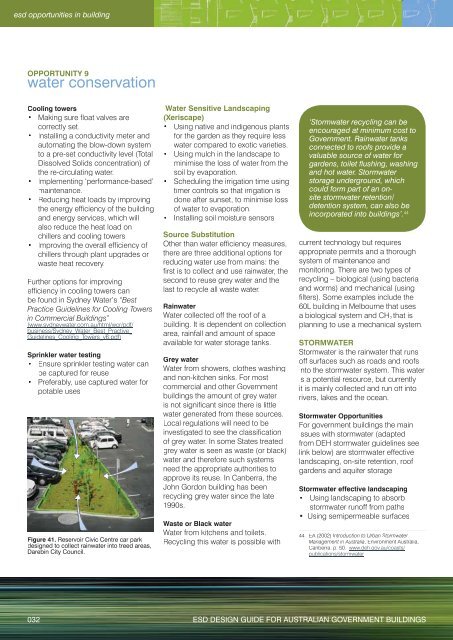
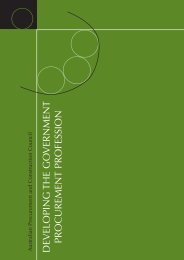
![NATIONAL COST ADJUSTMENT PROVISION EDITION 2 [NCAP2]](https://img.yumpu.com/48266135/1/184x260/national-cost-adjustment-provision-edition-2-ncap2.jpg?quality=85)


